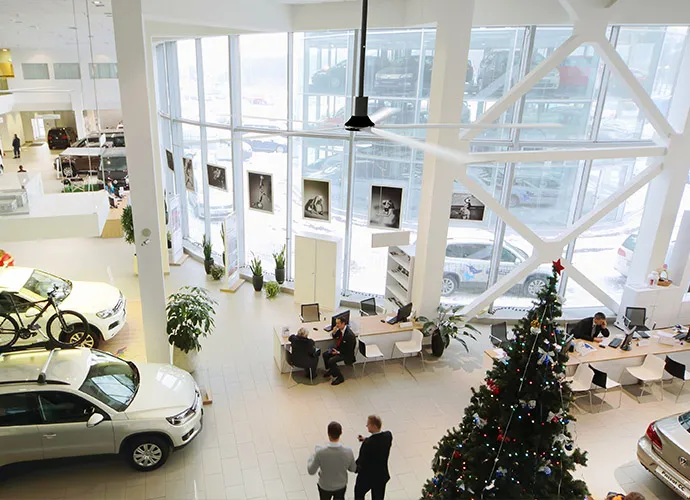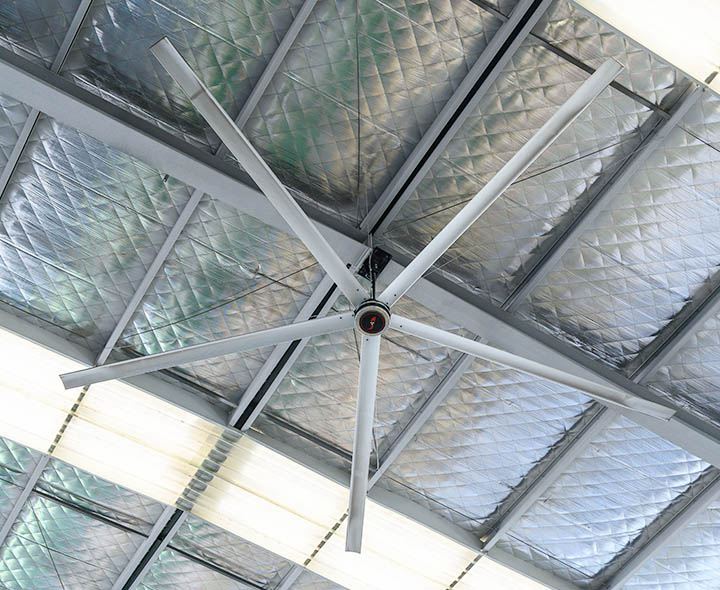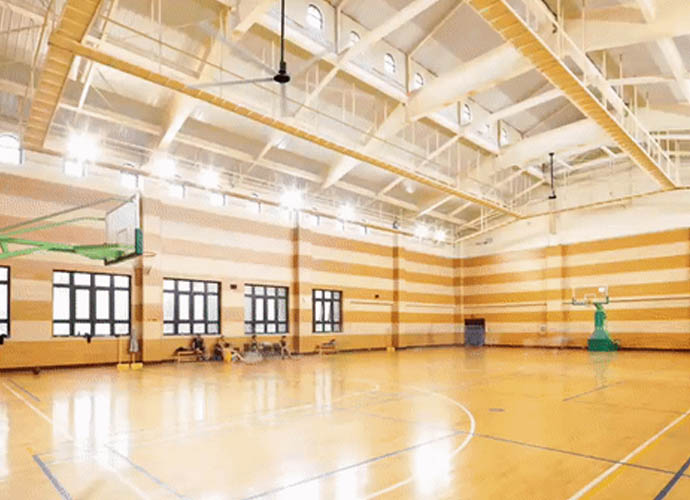Large spaces get hot fast, energy bills spike, and comfort drops. That’s a real problem. It can agitate teams, slow work, and raise costs. A simple, cost-effective cooling solution exists: pair HVLS fans with smart controls—and use AC only when you truly need it.
For most large buildings, the least expensive way to 凉爽的 is using HVLS 风扇 as the primary 冷却解决方案 (air movement and destratification) and running 空调 only as needed. In dry climates, add 蒸发冷却. This hybrid approach minimizes upfront costs and slashes 能源消耗 while keeping occupants 凉爽的.

What Is the Least Expensive Cooling System for Large Buildings?
“Least expensive” isn’t one-size-fits-all. A 商业大厦 in Phoenix has different cooling demands than one in Seattle. Dry air favors evaporative systems; humid regions lean on central air conditioning. Big open floors (warehouses, gyms) need air movement to 凉爽的 people; offices need zoning to 凉爽的 smaller rooms.
Two cost buckets matter: upfront and “costs over time.” Upfront costs cover equipment and install; lifetime costs include 能源消耗, 维护成本, and controls. Heating and 降温 together drive a large share of building energy. Focusing on movement (fans) first, then targeted 降温, keeps it 凉爽的 for less. The Department of Energy notes heating and 降温 dominate building energy use, so small efficiency improvements pay back quickly.
Takeaway: Start with air movement to 凉爽的 people and destratify heat, then add just enough “cold” to meet code and comfort.
Helpful resource: See practical examples of HVLS 吊扇 sized for 大型商业 areas on our product pages (try this guide to HVLS ceiling fans for large commercial spaces).
超大吸力 (High Volume, Low Speed) fans move massive air gently, creating a noticeable 凉爽的 feeling (the “feels-like” drop) without dropping the actual air temperature. Studies show a 4–6 °C (≈7–10 °F) perceived reduction—so people feel 凉爽的 at higher thermostat setpoints. That’s 节能 comfort.
In winter, HVLS fans reverse to destratify warm layers, improving uniform cooling in summer and uniform heating in winter. This reduces 能源成本 and helps the system operates in its sweet spot. ASHRAE-published work on hangars shows destratification cuts wasted heat and lowers operating costs. Systems are designed to mix layers and reduce waste; systems can save significant energy when tuned well.
Explore real-world hardware: Compare our best HVLS fans for warehouses to balance airflow and 凉爽的 coverage across racks and open aisles.
Large buildings have four mainstream cooling options to consider:
Evaporative systems can use dramatically less electricity than DX 空调 units, though climate matters; several sources show lower running costs, sometimes far lower, in suitable dry regions. In very hot/humid summers, effectiveness drops and buildings may shift to AC.
Table 1: Typical cost and fit (order-of-magnitude, varies by region and spec)
| 选项 | Upfront ($/ft²) | Energy use | Best fit |
|---|---|---|---|
| HVLS 风扇 | 低的 | Very low electricity; big coverage | Warehouses, gyms, sports centers |
| Evaporative | Low–Mid | Low electricity + water | Dry climates, semi-open spaces |
| Central air (DX/chiller) | Mid–High | Higher electricity | Offices, hospitals, data rooms |
| VRF | ~20–27 $/ft² (typical) | Mid; excellent zoning | Retrofits, mixed-use areas |
VRF installed cost range example from an industry budgeting guide; actual projects vary widely.
See application guides: For a gym or sports arena retrofit, review our commercial ceiling fans for sports centers and airflow layout tips.
Both. In many large commercial buildings, HVLS fans alone keep people 凉爽的 enough for light work when ambient is moderate. When heat peaks, HVLS fans reduce AC runtime by raising setpoints while keeping it 凉爽的 to the skin. That “凉爽的 feel” is why pairing movement with limited “cold” is so powerful.
In offices or humid climates, HVLS fans 凉爽的 people while AC handles latent load (moisture). You still heat and cool with your plant, but the fan layer means the conditioning system runs less to 凉爽的 the same 居住者. In practice, cooling your commercial interior with fans first, then supplementing with 空调系统 cycles, trims 能源账单 and keeps a steady, 凉爽的 vibe.
Warehouse example: Start with two to four cooling units (evap or DX) for zones with the highest cooling requirements, then blanket the space with HVLS for 凉爽的 air movement. That’s the right cooling solution for many open floors.

Can HVLS fans replace air conditioning?
We want low upfront pain and low “costs over time.” HVLS is usually the cheapest square-foot 降温 coverage to install and the cheapest to run. Evaporative adds low-cost “cold” if your climate is dry. AC or VRF add precise “cold” when humidity or process loads demand it.
Table 2: What you actually pay for over 10 years
| Cost bucket | HVLS 风扇 | Evaporative | Central Air | VRF |
|---|---|---|---|---|
| Purchase & install | 低的 | Low–Mid | Mid–High | 高的 |
| 电力 | 非常低 | 低的 | 高的 | Mid |
| Water | None | 是 | None | None |
| Service | 低的 | Low–Mid | Mid | Mid |
| Control upgrades | Easy | Easy | Varies | Varies |
DOE/EIA sources show heating/降温 take a big slice of building energy; trimming runtime is where the money is. Pairing movement + targeted “cold” lowers operating costs 和 减少能源 use.
See it in practice: For manufacturing floors, compare layouts in our 用于制造业的工业吊扇 resource; it shows how to 凉爽的 process aisles without over-sizing chillers.
能源效率 is not just fancy equipment—it’s how you use it. Air movement lets you raise AC setpoints and stay 凉爽的. ASHRAE-featured research on hangars demonstrates destratification reduces waste heat at the ceiling—improving performance and energy outcomes.
Consider this simple picture:
Reality check: 节省能源 depends on climate and schedule. But across many facilities we support as an HVLS manufacturer, the pattern is clear: less compressor time, same or better 凉爽的.
一个 cooling strategy that aligns with how you use the space will always beat a generic setup. Schedule fans to pre-move air before shift changes so people feel 凉爽的 walking in. Use destratification in shoulder seasons to keep temps 凉爽的 and even.
Link fans to BAS so the system operates together: when sensors see rising temps, ramp fan speed first; trigger AC only if the setpoint is missed for a few minutes. That keeps it 凉爽的 while protecting equipment.
Resource: For open-plan 商业大厦 lobbies, see our guide to HVLS fans for commercial buildings—it shows how to maintain 凉爽的 comfort from doors to elevators.

Cooling strategies that align with commercial building operations
Don’t chase tons; chase comfort. Start with people density, activity level, and air speed targets that feel 凉爽的. Then check 冷却功率 和 cooling output from your plant. Choosing a cooling system is easier when you model airflow first—HVLS covers huge diameters, so you 凉爽的 more with fewer devices.
If you already have central air, right-sized HVLS keeps 凉爽的 air distributed and reduces hot spots. If you need “cold,” consider a heat pump 或者 heat pump systems with high SEER/IEER paired with fans. That combo 凉爽的s well and stays 节能.
Need a starting point? 我们的 HVLS fans for warehouse layouts show coverage maps you can adapt quickly to 凉爽的 high-bay racking.
People don’t work well when they’re not 凉爽的. Air movement boosts evaporative heat loss from skin, making it feel 凉爽的 without over-cooling the room. That protects the 员工环境 降低时 能源成本. Keep filtration, ventilation, and 室内空气质量 in mind; these matter as much as “cold.”
A note on sprinklers and safety: follow NFPA, FM, and local guidance when placing big fans near sprinklers. This ensures reliable 凉爽的 air movement and compliant protection. (See FM Global research on HVLS and sprinkler considerations for additional context.)
Smart controls and AI are helping commercial HVAC tune responses to weather and occupancy, trimming wasted 能源消耗. Case studies show notable HVAC savings with AI-driven optimization. Pair that with HVLS and you get optimal cooling with less compressor time.
In dry regions, modern indirect/direct evaporative systems add 凉爽的 efficiently; in others, heat recovery systems in VRF reclaim waste heat. Add solar power to offset daytime draw. These innovative cooling solutions keep it 凉爽的 while limiting environmental impact.
Trend snapshot: “Trends in commercial cooling” are less about giant new plants and more about smart layering: fans + targeted “cold” + controls.
Follow five simple steps to 凉爽的 smarter:
Want examples for different cooling or heating use-cases? Browse big industrial fans for manufacturing, quiet fan for sport-center arenas, and big commercial ceiling fans for commercial-building entrances to see layouts you can adapt today.
Simple comparison of electrical draw to feel “cool” in a 50,000 ft² open floor (illustrative):
| 设想 | Target feel | Approx. plant runtime | 说明 |
|---|---|---|---|
| AC only | “Very 凉爽的” | 100% | Lowest setpoint, highest kWh |
| HVLS + AC | “Cool” | ~70% | Higher setpoint; fans do comfort work |
| HVLS only | “Comfortably 凉爽的” | 0% (plant) | Good for mild days & warehouses |
Air movement lets you meet 凉爽的 perceptions with less compressor time; multiple studies show destratification and air speed can cut waste and improve comfort.
Isn’t the cheapest system just a big AC?
Not usually. For cooling large open floors, a big AC alone is expensive to buy and run. HVLS fans are a 成本效益 base layer; then you add just enough AC to stay 凉爽的 on peak days.
Will fans make it too cold near the floor?
No. Properly sized HVLS creates gentle air speed so people feel 凉爽的, not drafty. In winter, fans run low to destratify. The system won’t over-chill when controls are set right.
Can HVLS work with existing central air?
Yes. Fans spread 凉爽的 air evenly, so central air cycles less. That improves comfort for every 居住者 and may lower operating costs.
What about water use for evaporative systems?
Evaporative can be very energy-efficient cooling in dry climates but uses water. In humid zones, it’s less effective, and many sites favor AC plus HVLS to keep it 凉爽的.
Do these systems help with heat, too?
是的。HVLS 辅助设备 cooling and heating via destratification. Pairing with heat pump tech can handle heating or cooling year-round.
How do I pick the right gear?
Use airflow first. Size HVLS to the geometry, then choose the smallest “cold” plant to meet the last few degrees. That’s the right commercial approach for comfort and savings.
In our experience as an HVLS 风机制造商, starting with movement makes every other choice smaller, simpler, and cheaper—while your teams stay 凉爽的 and productive.
| Building type | Best first move | 为什么 |
|---|---|---|
| Warehouse & logistics | HVLS + targeted AC | Big volume needs air movement to feel 凉爽的; add “cold” only to problem zones |
| Gym & sports center | HVLS + fresh air | Activity level is high; air speed keeps athletes 凉爽的 |
| Commercial lobby | HVLS + BAS | Door swings cause spikes—fans keep it 凉爽的 and even |
| 制造业 | HVLS + process zoning | Keep lines 凉爽的 without over-cooling storage zones |
Sources you can trust
Final action
Summary: the most important things to remember
Note: The hybrid HVLS + targeted “cold” approach offers reliable 凉爽的 comfort with minimal 能源消耗, lower operating costs, and strong payback for your commercial property—a practical, 节能 path to cooling your space 今天。